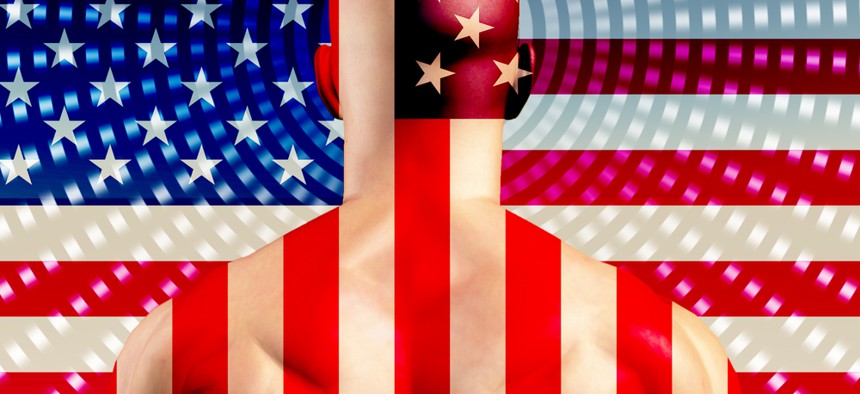
Image via Bruce Rolff/Shutterstock.com
Service To America Medal Finalists: National Security And International Affairs
The finalists for the 2013 Sammies have been announced.
Each year numerous unsung civil servants respond to global crisis involving defense, military affairs, diplomacy, foreign assistance and trade.
On Oct. 3, the Partnership for Public Service will present the prestigious Samuel J. Heyman Service to America Medal for National Security and International Affairs to one of the four finalists profiled below, individuals whose accomplishments include heading a U.S. humanitarian relief effort in the Horn of Africa, leading a successful campaign to eradicate polio in India, devising methods to protect humans and livestock overseas from disease-carrying insects and providing Chinese citizens with accurate information about the full extent of air pollution in their cities.
These public servants are among 31 medal finalists honored in seven categories ranging from justice and law enforcement to science and environment. Here are the stories of the Service to America Medal finalists for National Security and International Affairs.
Cara Christie: Led USAID humanitarian to drought crisis in Somalia, Kenya and Ethiopia
The African nations of Somalia, Kenya and Ethiopia were reeling in 2011 and 2012 from the region’s worst drought in 60 years. Malnutrition and death rates soared, crops failed, livestock died and food prices skyrocketed. At the height of the crisis, more than 13 million people were in need of life-saving assistance.
The international community responded to the humanitarian crisis, with the United States providing $1.3 billion in aid to the region that included food, water, emergency health, nutritional care and other assistance.
Leading the large and complex American relief effort was Cara Christie, a disaster-operations specialist with the U.S. Agency for International Development (USAID), who is credited with recognizing the significance of the impending famine almost a year before it unfolded. Christie convinced her superiors of the need to act and to be proactive instead of reactive by making advance preparations in the fall of 2010—a move that hastened aid to the region and saved lives.
“Because of her quick action and anticipation, hundreds of thousands of people were saved and their suffering was mitigated,” said Carol Chan, the acting director of USAID’s Office of U.S. Foreign Disaster Assistance (USAID/OFDA).
Hamid Jafari: Directed successful initiative to eradicate polio in India
The elusive goal of ridding the world of polio is closer than ever now that the crippling disease has been halted in India, the largest of the four countries in which the virus continued to exist.
Critical to this impressive achievement was Dr. Hamid Jafari, a medical officer from the Centers for Disease Control and Prevention (CDC). Jafari managed a public health initiative between the government of India and the World Health Organization (WHO), directed a staff of more than 2,300 people and oversaw the delivery of about 1 billion doses of the polio vaccine to 172 million young children each year between 2008 and 2011. Many of these children were from migrant families or were living in hard-to-reach and high-risk areas.
“India was long thought to be the most difficult country to eradicate polio in the world, but Hamid’s technical and leadership expertise was able to prove the skeptics wrong,” said Dr. Bruce Aylward, WHO’s assistant director general.
Reports ranged from 559 to 874 cases in India annually between 2006 and 2009, comprising 43 percent of the confirmed cases worldwide. That number reached zero in January 2011 and a year later, India completed a designated 12-month period without a single occurrence. The next month, India was removed from the list of polio-endemic countries.
Dr. Rebecca Martin, director of the Global Immunization Division at CDC said Jafari, who was on loan to WHO, “had innovative solutions such as vaccinations at bus stops and on trains, and he found ways to reach the children of migrant workers. He identified where the populations were and made sure they were vaccinated.”
Kenneth J. Linthicum: Protecting humans and livestock from disease-carrying insects
Tiny insects, from mosquitos to sand flies, spread diseases that annually kill and sicken millions of people and animals worldwide.
Kenneth Linthicum is one of the nation’s leading experts on insects and disease prevention, having invented a successful surveillance system that predicts the onset of the mosquito-borne Rift Valley fever in Africa and the Middle East that devastates domestic livestock and causes human illness. He also developed techniques that have protected U.S. military personnel overseas from debilitating afflictions caused by sand flies.
“His work has provided the research findings needed to protect literally millions of people from disease and to save agriculture billions of dollars,” said Steven Kappes, a deputy administrator of the U.S. Department of Agriculture’s (USDA) Agricultural Research Service.
Edward Knipling, administrator of the Agriculture Research Service, said Linthicum, the director of the USDA Center for Medical, Agricultural and Veterinary Entomology, has done seminal work forecasting “how and when new diseases could come, and how we could deal with those diseases.”
Erica Keen Thomas: Led U.S. embassy team that documented harmful air pollution levels in China
Noxious, choking air pollution has smothered Beijing and other major Chinese cities for years, making it difficult for people to breathe and causing an estimated 1.2 million premature deaths in 2010 alone. But until recently, the Chinese government routinely dismissed the public health risk.
A major cause of China’s gray skies was publicly revealed when the Environment, Science, Technology and Health Section at the U.S. Embassy in Beijing, currently led by Erica Thomas, placed a single air monitor on top of the embassy to take their own air pollution readings, and then began publishing that information on Twitter for American citizens living there.
The move resulted not only in Americans using the data to try to reduce their exposure to harmful air pollution, but Chinese citizens in Beijing also became aware of the extent of the problem.
The access to real time air pollution data along with relevant U.S.-approved health advisories generated enough public pressure within China for the Chinese government to adopt improved measurement standards beginning in 2016, and for the city of Beijing and 73 other municipal authorities to begin reporting more accurate daily readings starting in 2012.
“I’ve never seen an initiative of the U.S. government have such an immediate, dramatic impact in a country,” said U.S. Ambassador Gary Locke. “We engage the Chinese government and people on a wide range of issues from human rights to the rule of law. The response by the Chinese people and government on the environment has been unprecedented.”
Lara Shane is Vice President of Research and Communications at the nonprofit Partnership for Public Service. This article is the second in a series on the Samuel J. Heyman Service to America Medal (Sammies) finalists. For information about the awards and how to nominate a federal employee for a medal, go to servicetoamericamedals.org. The 2013 Sammies program is supported by national sponsors Booz Allen Hamilton, Boston Consulting Group, Chevron, ConantLeadership and United Technologies Corporation.
Image via Bruce Rolff/Shutterstock.com







